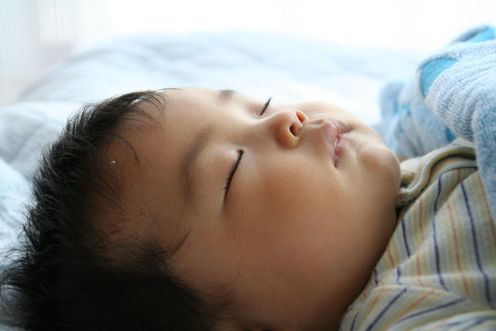
Every evening, parents across Australia hope their babies will sleep through the night. Many won’t. That’s where controlled comforting, or controlled crying might help. Contrary to some claims, this is a safe and effective method for settling babies.
Sleepless nights are not uncommon. A 2001 study of 700 Victorian mums of seven-month-old babies found sleep was a problem for nearly half. This can cause serious problems for some parents: women who said their baby’s sleep was a problem were twice as likely to experience symptoms of postnatal depression.
Sleep happens in cycles. We start out awake, then fall into light sleep and then deep sleep, before moving into wakefulness and so on. For adults, one of these cycles lasts around 90 minutes. For babies and children, it’s around half this time. This means babies and children naturally stir and wake a lot more than their parents.
We have to learn the skill of falling asleep on our own. If a baby develops a habit of needing a parent to be with them to fall asleep (such as being rocked to sleep), that’s often when parents say that their baby’s sleep is a problem. From around three months of age, one of the most helpful things parents can do is to start a positive bedtime routine that can help their baby settle.
Once babies are about six months old, if they have trouble falling asleep by themselves, they can be taught this skill so they don’t cry out for mum or dad when they wake up naturally. One of the fastest and most effective ways to do this is called “controlled comforting” which is also known as “controlled crying”.
In controlled comforting, parents put their baby to bed tired but awake, and leave them to settle for short, increasing periods of time, even if they cry. Parents choose which time intervals are best for their family. Examples are: two minutes, then four minutes, then six minutes, then eight minutes; or two, five, ten minutes; or two, five, five, five minutes.
A more gradual method called “camping out” might be the way to go for some families. This is where a parent lies on a camp bed or sits in a chair next to their baby’s cot to settle the baby when he or she cries. Over a couple of weeks, the parent gradually moves the chair or bed away from the cot and out the door, until the baby is falling asleep without the parent in the room.
In 2004, Melbourne researcher Harriet Hiscock tested these two methods with more than 300 mums and babies in the largest and longest study to evaluate infant sleep strategies.
Half the families were offered positive bedtime routines, “controlled comforting” and “camping out”, with parents free to choose the strategies they wanted to try. The other half weren’t. This study design – a randomised controlled trial – provides the “gold standard” or highest level of evidence about whether a program works.
Just by offering these extra sleep strategies to families, children’s sleep improved and mothers’ depression symptoms reduced. The effects lasted to when babies turned two years old, 16 months after the program was offered.

The techniques offered are not the same as “crying-it-out”, which is also known as “pure extinction”. In crying-it-out, the baby is put to bed and left for the whole night before being checked on in the morning. While this technique has also been shown to improve babies’ sleep, it can be distressing for parents and babies.
“Controlled crying” and “camping out” can still be hard for parents, as they listen to their baby cry for short periods and try not to respond. Rest assured, these methods not only work, they are safe for babies’ long-term mental health and development.
To test whether there are any long-lasting effects for the mums or the kids, I led the Kids Sleep Study in 2009. We got back in touch with the families who were part of the first study in 2004. By 2009, the kids were six years old and had started school.
We visited mums and kids at home to collect information about their health and well-being. We asked mums about their child’s behaviour, how the kids were going at school and about their own relationship with their child. We interviewed the kids about their own health and well-being and collected saliva to measure their stress (cortisol) levels.
We found that there were absolutely no differences between the families who were offered the sleep strategies and those that weren’t. This told us that for babies older than six months, these sleep strategies work and are safe to use.
Parents and health professionals looking for a way to manage sleep when babies are older than six months can feel confident using “controlled comforting” and “camping out”.
For more information about children’s sleep and how to manage it, visit Raising Children Network. This government-funded non-profit site gives all the current evidence on children’s development and sleep by age group.
Anna Price does not work for, consult to, own shares in or receive funding from any company or organisation that would benefit from this article, and has no relevant affiliations.
